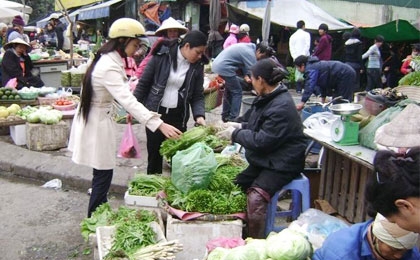Mixed messages leave market uneasy
 |
| illustration photo - source : doctin.vn |
The government has set a year-on-year CPI increase target of 7 per cent for 2011. In its latest economic report on Vietnam, Credit Suisse Group forecasted Vietnam’s inflation would be 10 per cent in 2011.
But according to Robert Prior-Wandesforde, Credit Suisse Group AG’s economist for India and South-East Asia, the real problem for the country is that such signs of overheating are emerging at a time when the economy expanded just 5.3 per cent in 2009 and 6.8 per cent in 2010.
These levels are well below what many, including the government, believe is sustainable for a rapidly emerging economy like Vietnam.
“The implication would seem to be that the growth/inflation trade-off has deteriorated. Notwithstanding the recent base rate
rise which is likely to be backed up by a further 1 per cent move in 2011, we believe the government’s preference generally remains for growth over inflation,” said Prior-Wandesforde.
At the moment, the base rate is set at 9 per cent.
However, earlier this month, the State Bank twice lifted the 7-day lending rate to local banks via the open market operation (OMO) window from 8.75 to 11 per cent per year.
Currently, with collateral being valuable paper such as government bonds, the central bank is lending to local banks at 11 per cent per year.
According to an executive from the Vietnam Bank for Industry and Trade (Vietinbank), these raises could be signs of monetary tightening. “As an important channel for local lenders to get short-term fund, higher borrowing cost on OMO can make banks’ average mobilisation interest rate higher in general,” said the Vietinbank executive.
However, at a conference held by the National Assembly’s Economic Committee late last December, state bank governor Nguyen Van Giau clearly stated that the central bank would try to reduce the market interest rate to better support local enterprises.
In late December, as local lenders lifted deposit rates en masse to attract customers, the State Bank asked banks not to set deposit rate higher than 14 per cent per year.
Le Xuan Nghia, vice head of Vietnam’s National Financial Surveillance Commission even expected the mobilising rate would come down to 12 per cent per year by end of the first quarter and 10 per cent per year by end of the this year’s third quarter.
Sherman Chan, HSBC’s Southeast Asia economist said that a clear policy monetary tightening was needed to rein in inflationary pressures.
“The authorities seem to be still tossing up between boosting growth and curbing inflation. Recent policy actions suggest that there is still a bias towards growth,” said Chan
What the stars mean:
★ Poor ★ ★ Promising ★★★ Good ★★★★ Very good ★★★★★ Exceptional
Related Contents
Latest News
More News
- VIR workshop highlights capital and policy for sustainable development (December 15, 2025 | 11:00)
- National Assembly approves pilot mechanisms to accelerate major projects in Hanoi (December 12, 2025 | 11:29)
- Vietnam eases policy approval requirements, simplifies foreign and outbound investments (December 11, 2025 | 17:53)
- Unpacking new momentum in Vietnam’s M&A market (December 10, 2025 | 09:59)
- Forum honours outstanding M&A deals, strategies, and advisory firms (December 09, 2025 | 18:22)
- Vietnam enters defining phase of M&A growth (December 09, 2025 | 17:00)
- Vietnam’s M&A market opens new opportunities amid strong economic momentum (December 09, 2025 | 15:00)
- Vietnam M&A Forum 2025: new position, new momentum (December 09, 2025 | 14:30)
- FDI in Vietnam jumps on additional capital and share purchases (December 09, 2025 | 13:56)
- VIR gathers dealmakers for M&A forum (December 08, 2025 | 17:17)

 Tag:
Tag:

















 Mobile Version
Mobile Version